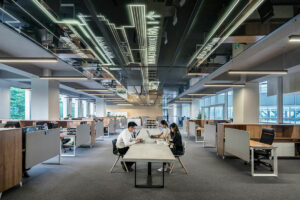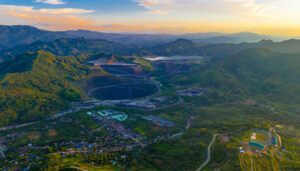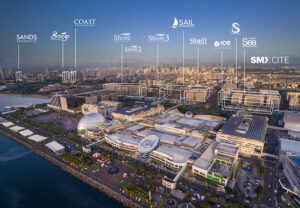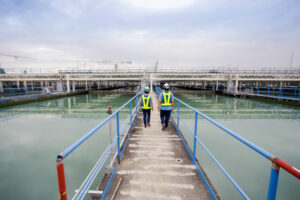Metro Manila office vacancy seen below 20% by yearend

By Beatriz Marie D. Cruz, Reporter
OFFICE VACANCY in Metro Manila is expected to fall below 20% by the end of this year, as most Philippine offshore gaming operator (POGO) occupiers have left the market, with vacancies offset by demand from the information technology and business process management (IT-BPM), healthcare, and banking industries, according to real estate services and investment firm CBRE.
“I think we’re going to definitely go below 20% by the end of the year, as we will see less vacated spaces from the POGO sector,” CBRE Philippines Country Head Jie C. Espinosa told BusinessWorld on the sidelines of the CBRE Philippines Start of the Year 2025 Market Monitor, a forum held last week.
“The main reason why vacancy had increased in the past two quarters is primarily because of the POGO ban, but now that we’ve seen the bulk of it, I think that the situation will be better, provided that the demand figures will be sustained as well.”
Office vacancy in Metro Manila rose to 20.1% in the first quarter from 19.9% in the third and fourth quarters of 2024, after President Ferdinand R. Marcos, Jr. banned POGOs in August last year.
Demand from the IT-BPM, healthcare, and banking, financial services, and insurance sectors helped absorb the vacancies left by POGO move-outs, Mr. Espinosa said.
The Metro Manila office market saw a 7% year-on-year decline in demand to 161,500 square meters (sq.m.) amid the absence of POGOs, CBRE said.
Office vacancy in Metro Manila climbed to a record-high 966,700 sq.m. from January to March — the highest in three years, or since the 960,140 sq.m. recorded in the first quarter of 2022. This also accounted for 53% of the available supply in the market.
POGOs accounted for 42% of move-outs in the first quarter, followed by the IT-BPM sector (35%) and traditional offices (23%).
By submarket, the highest number of vacated spaces was recorded in Makati at 226,600 sq.m., followed by the Bay Area at 210,000 sq.m., and Quezon City at 204,700 sq.m.
As of the first quarter, Metro Manila had a total office supply of 1.81 million sq.m., with 822,700 sq.m. in unleased space and 24,600 sq.m. in new supply.
For Metro Manila, CBRE expects about 389,600 sq.m. of new office supply in 2025, 332,900 sq.m. in 2026, 168,400 sq.m. in 2027, 188,500 sq.m. in 2028, and 211,000 sq.m. in 2029.
Meanwhile, the industrial and logistics sector recorded lackluster demand at 54,130 sq.m., plunging by 53.34% from the 116,000 sq.m. posted in the fourth quarter of 2024. It also fell by 45.32% from the 99,000 sq.m. in the same period last year.
This mainly covers the industrial and logistics hubs of Cavite, Laguna, and Batangas (CALABA), CBRE said.
The overall vacancy rate for the CALABA industrial submarkets rose to 9.6% in the first quarter from 9.2% in the fourth quarter last year, Zoilo L. Paras, senior manager for capital markets and investments at CBRE, said.
“We already noted some large manufacturing clients of ours that paused or deferred their requirement, primarily because they were waiting for what’s going to happen after [US President Donald J.] Trump takes office,” Mr. Paras said after the briefing.
As of end-March, the CALABA industrial market had 619,510 sq.m. of total available warehouse space. Of this, 270,575 sq.m. are in Laguna, 188,470 sq.m. in Batangas, and 160,466 sq.m. in Cavite.
In the coming months, the industrial and logistics sector may benefit from the Philippines’ relatively lower US tariff rate of 17%, the second lowest among the Association of Southeast Asian Nations countries.
Mr. Trump in April announced a 90-day pause on reciprocal tariffs with the United States’ trading partners but retained a 10% levy on most US imports.
“The Philippines is poised to benefit from all the regional shifts happening in the manufacturing sector across the region brought about by the reciprocal tariffs,” Mr. Paras said. “However, our limited and aging inventory could cause us to miss out on this opportunity.”
For instance, a typical manufacturing facility relocating from China would require 15,000 to 30,000 sq.m. of space. However, many of the country’s available spaces range from 3,000 to 5,000 sq.m. and are mostly over 10 years old, Mr. Paras noted.
To attract foreign investors, industrial and logistics developers must also incorporate modern and sustainability features in their facilities, he added.
About 79,669 sq.m. of upcoming industrial space is expected this year, CBRE said, with most of the supply coming from Laguna at 65,994 sq.m., followed by Cavite (7,486 sq.m.) and Batangas (6,189 sq.m.).




